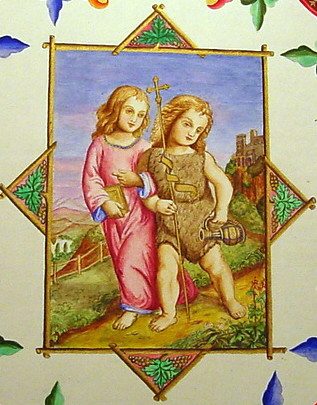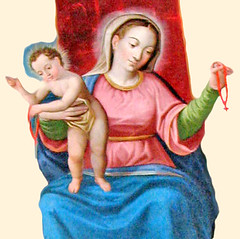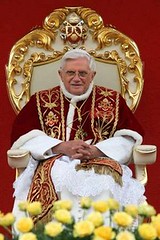"I must decrease, that He may increase"
 The Nativity of St John the Baptist is one of only three birthdays celebrated in the Sanctoral, the others being the births of Our Lord and Our Lady. The Eastern Church celebrates not just two but as many as six feasts of the 'Forerunner' or 'Precursor', as St John is known. This attention paid to the last and greatest of the prophets, the second Elijah is not surprising. Of him, Jesus Christ himself said: "Among those born of women no one has arisen greater than John the Baptist..." Of course, what is startling about the Lord's proclamation is that he concludes by saying that, "yet the least in the kingdom of heaven is greater than he" (Mt 11:11). It is with this perspective that we celebrate today's Solemnity. This is not by any means to lesses the Fore-runner's importance but it is once again a reminder of just how awesome is the redemptive work of Christ. For the least in the kingdom of heaven share in the very Godhead of the Most Holy Trinity, divinized by the condescension of Christ and given the Spirit of adoption (cf Rom 8:15ff).
The Nativity of St John the Baptist is one of only three birthdays celebrated in the Sanctoral, the others being the births of Our Lord and Our Lady. The Eastern Church celebrates not just two but as many as six feasts of the 'Forerunner' or 'Precursor', as St John is known. This attention paid to the last and greatest of the prophets, the second Elijah is not surprising. Of him, Jesus Christ himself said: "Among those born of women no one has arisen greater than John the Baptist..." Of course, what is startling about the Lord's proclamation is that he concludes by saying that, "yet the least in the kingdom of heaven is greater than he" (Mt 11:11). It is with this perspective that we celebrate today's Solemnity. This is not by any means to lesses the Fore-runner's importance but it is once again a reminder of just how awesome is the redemptive work of Christ. For the least in the kingdom of heaven share in the very Godhead of the Most Holy Trinity, divinized by the condescension of Christ and given the Spirit of adoption (cf Rom 8:15ff).Among those who consider St John the Baptist as their patron are French Canada, tailors, shepherds and the Sovereign Military Order of Malta. To give the latter its full name, it is the Sovereign Military Hospitaller Order of St John of Jerusalem, of Rhodes, and of Malta. This is the oldest chivalric order in the world and was founded in 1070 in Jerusalem by Bl Gerard Tonque as a hospice for Christian pilgrims to the Holy Land. The hospice was named in honour of St John the Baptist and thus they claimed him as their patron. Following the crusades and with the vissicitudes of time, the Order retreated from Jerusalem and then Rhodes and finally Malta, but rather unusually, they are still afforded sovereign status and their 'headquarters' in Rome on the famed Via Condotti (the Magistral Palace) can lay claim to being the smallest state in Europe! As such, the Order is ruled by the Prince Grand Master who is currently an Englishman and carries the style of 'His Eminent Highness'. Among its current membership is this Pope, Benedict XVI. The Order's unique history and position unfortunately gives it an air of anachronism and it is frequently misunderstood and regarded as elitist because of its 'proof of nobility' requirement for membership. This is far from accurate as the Order (quietly) still does a tremendous amount of good work, serving those they call "our lords, the sick." Their annual Lourdes pilgrimage manages to link the Order to their original aim of hospital work among sick pilgrims.

A good friend of mine is a member of the Order and when appropriate he dons their habit which is called the cuculla. It is basically a black woolen long tunic emblazoned with the Maltese cross and sporting cuffs and a cowl of white watered silk. Incidentally, the eight-pointed Maltese cross is so formed because the eight points remind us of the Beatitudes which the Order took as their Constitution. When the Postulant is invested in the habit, the Grand Master says:
"This is our Habit, in the form of the garment of camel-hair which our Patron, St John the Baptist, wore in the desert for his severe penance. Therefore you shall strive to wear it as a penance for your sins..."
However, I fear the watered silk rather betrays the idea of penance and I think it is rather fanciful to compare the long medieval garment of wool to the camel-hair garb of St John! One source reveals that the habit used to made of camel-hair. Presumably when they were expelled from the Holy Land, this became a rarity?! But such idiosyncracies add to the charm and mystique of this ancient order of knights...
St John's day is also associated with some interesting practices, some of pagan origin. In the Philippines, I was warned not to walk about the streets as passers-by were given dousings in dubious honour of the Baptizer on this day. Throughout Europe and especially in Scandinavia, bonfires were lit. The Dominican Bl Jacobus de Voragine who wrote the charming 'The Golden Legend', perhaps the most widely read book in medieval Europe after the Bible explains it in this way:
"There are people who on this day burn the bones of dead animals, collected wherever they are found... A preventative against [the danger of plague-causing dragons] was invented that consisted of making a bonfire of the bones of animals, the smoke from which drove the dragons away. Since this was usually done around the time of St John's feast day, some people continue to observe the custom. The other reason is to represent the burning of St John's bones by the infidels in the city of Sebaste" where he is reputed to have been buried by his disciples. "Lighted torches are also carried around this bonfire, because John was a burning and shining torch, and a wheel is spun because the sun then begins to be lower in its cycle. This signifies the decline of St John's fame, by which he was thought to be Christ, as he himself testified when he said: 'I must decrease, but he must increase.' According to St Augustine, this is also signified in their births and deaths. About the time of John's birth the days begin to be shorter, and about the time of Christ's birth they grow longer..."Whatever the reasons for these festivities, it remains that St John the Baptist's day is a significant date in the calendar, not least for us Christians because it gives us pause to reflect on his words mentioned above. Echoing John's humility, whose voice gave way to the Word, we too can deflate our egos, humble ourselves and allow God's grace, Jesus himself to be seen through our lives. Only then shall we be least in the kingdom of heaven, when we are caught up in the divine life of God, consumed by Love.
The photo above shows the Child Jesus with his cousin, St John. It is a hand-illustrated detail taken from 19th century 'Term Books' in the archives of Ushaw College.







0 Comments:
Post a Comment
<< Home